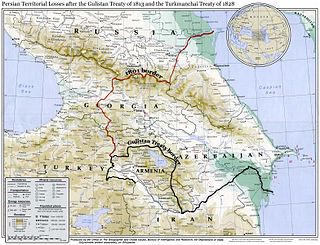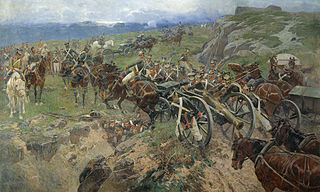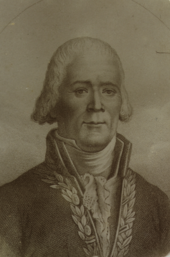
Abbas Mirza was a Qajar crown prince of Iran. He developed a reputation as a military commander during the Russo-Persian War of 1804–1813 and the Russo-Persian War of 1826–1828, as well as through the Ottoman–Persian War of 1821–1823. He is furthermore noted as an early modernizer of Persia's armed forces and institutions, and for his death before his father, Fath Ali Shah.

Mohammad Shah was the third Qajar shah of Iran from 1834 to 1848, inheriting the throne from his grandfather, Fath-Ali Shah. From a young age, Mohammad Mirza was under the tutelage of Haji Mirza Aqasi, a local dervish from Tabriz whose teachings influenced the young prince to become a Sufi-king later in his life. After his father Abbas Mirza died in 1833, Mohammad Mirza became the crown prince of Iran and was assigned with the governorship of Azarbaijan. After the death of Fath-Ali Shah in 1838, some of his sons including Hossein Ali Mirza and Ali Mirza Zel as-Soltan rose up as claimants to the throne. With the support of English and Russian forces, Mohammad Shah suppressed the rebellious princes and asserted his authority.

Fath-Ali Shah Qajar was the second Shah (king) of Qajar Iran. He reigned from 17 June 1797 until his death on 24 October 1834. His reign saw the irrevocable ceding of Iran's northern territories in the Caucasus, comprising what is nowadays Georgia, Dagestan, Azerbaijan, and Armenia, to the Russian Empire following the Russo-Persian Wars of 1804–1813 and 1826–1828 and the resulting treaties of Gulistan and Turkmenchay. Historian Joseph M. Upton says that he "is famous among Iranians for three things: his exceptionally long beard, his wasp-like waist, and his progeny."

The Treaty of Gulistan was a peace treaty concluded between the Russian Empire and Qajar Iran on 24 October 1813 in the village of Gulistan as a result of the first full-scale Russo-Persian War. The peace negotiations were precipitated by the successful storming of Lankaran by General Pyotr Kotlyarevsky on 1 January 1813. It was the first of the series of treaties signed between Qajar Iran and Imperial Russia that forced Persia to cede the territories that formerly were part of Iran.

The Treaty of Finckenstein, often spelled Finkenstein, was a treaty concluded between France and Persia (Iran) in the Finckenstein Palace on 4 May 1807 and formalised the Franco-Persian alliance.

Pierre Amédée Emilien Probe Jaubert was a French diplomat, academic, orientalist, translator, politician, and traveler. He was Napoleon's "favourite orientalist adviser and dragoman".

Claude-Matthieu, Comte de Gardane was a French general and diplomat. He entered the army and rose rapidly during the revolutionary wars, becoming captain in 1793.
The Russo-Persian Wars or Russo-Iranian Wars were a series of conflicts between 1651 and 1828, concerning Persia (Iran) and the Russian Empire. Russia and Persia fought these wars over disputed governance of territories and countries in the Caucasus. The main territories disputed were Aran, Georgia and Armenia, as well as much of Dagestan – generally referred to as Transcaucasia – and considered part of the Safavid Iran prior to the Russo-Persian Wars. Over the course of the five Russo-Persian Wars, the governance of these regions transferred between the two empires. Between the Second and Third Russo-Persian Wars, there was an interbellum period in which a number of treaties were drawn up between the Russian and the Persian Empires, as well as between both parties and the Ottoman Empire. Ottoman interest in these territories further complicated the wars, with both sides forming alliances with the Ottoman Empire at different points throughout the wars. Following the Treaty of Turkmenchay, which concluded the Fifth Russo-Persian War, Persia ceded much of its Transcaucasian territory to the Russian Empire.

The Russo-Persian War of 1804–1813 was one of the many wars between the Persian Empire and Imperial Russia, and began like many of their wars as a territorial dispute. The new Persian king, Fath Ali Shah Qajar, wanted to consolidate the northernmost reaches of his kingdom—modern-day Georgia—which had been annexed by Tsar Paul I several years after the Russo-Persian War of 1796. Like his Persian counterpart, the Tsar Alexander I was also new to the throne and equally determined to control the disputed territories.

French–Iranian relations are the international relations between France and Iran. Iran has generally enjoyed a friendly relationship with France since the Middle Ages. The travels of Jean-Baptiste Tavernier are particularly well known to Safavid Persia. France has an embassy in Tehran and Iran has an embassy in Paris.

The Franco-Ottoman alliance, also known as the Franco-Turkish alliance, was an alliance established in 1536 between Francis I, King of France and Suleiman I of the Ottoman Empire. The strategic and sometimes tactical alliance was one of the longest-lasting and most important foreign alliances of France, and was particularly influential during the Italian Wars. The Franco-Ottoman military alliance reached its peak with the Invasion of Corsica of 1553 during the reign of Henry II of France.

Various Franco-Indian Alliances were formed between France and various Indian kingdoms from the 18th century to the ascent of Napoleon. Following the alliances of Dupleix, a formal alliance was formed between by King Louis XVI during the American Revolutionary War in an attempt to oust the British East India Company from the Indian subcontinent. Later, numerous proposals of alliance were made by Tipu Sultan, leading to the dispatch of a French fleet of volunteers to help him, and even motivating an effort by Napoleon to make a junction with the Kingdom of Mysore through his 1798 campaign in Egypt.

Askar Khan Afshar was a Persia ambassador who was sent to Paris, during the period of the Franco-Persian alliance. He arrived in Paris on 20 July 1808 and met Napoleon on 4 September 1808 at Château de Saint-Cloud. He left in April 1810, as Persia in turn allied with Great Britain, then France's enemy in the Napoleonic Wars.
The Anglo-Persian Treaty of 1801 was signed between the English diplomat John Malcolm and the Shah of Persia Fath Ali Shah in 1801. The Treaty was proposed at the initiative of Great Britain in order to reinforce the Western border of British India, following the threat of French invasion during the Campaign of Egypt.

Major-General Sir Henry Lindsay Bethune, 1st Baronet, de jure 9th Earl of Lindsay was a Scottish military officer. He was a member of a British diplomatic and military mission led by John Malcolm to the Persian Empire in 1810.

Charles de Ferriol (1652–1722) was a French ambassador sent by Louis XIV to the Ottoman Empire from 1692 to 1711, during the rule of Sultan Ahmed III.

France–Asia relations span a period of more than two millennia, starting in the 6th century BCE with the establishment of Marseille by Greeks from Asia Minor, and continuing in the 3rd century BCE with Gaulish invasions of Asia Minor to form the kingdom of Galatia, and Frankish Crusaders forming the Crusader states. Since these early interactions, France has had a rich history of contacts with the Asian continent.

A Habsburg–Persian alliance, Habsburg-Safavid alliance or Habsburg-Iran alliance was attempted and to a certain extent achieved in the 16th century between the Habsburg Empire and Safavid Iran in their common conflict against the Ottoman Empire.
The foreign alliances of France have a long and complex history spanning more than a millennium. One traditional characteristic of the French diplomacy of alliances has been the "Alliance de revers", aiming at allying with countries situated on the opposite side or "in the back" of an adversary, in order to open a second front encircling the adversary and thus re-establish a balance of power. Another has been the alliance with local populations, against other European colonial powers.

Mirza Abolhassan Khan Ilchi was an Iranian politician and diplomat who served as the Minister of Foreign Affairs twice, first from 1824 to 1834, and then again from 1838 until his death in 1845. He also served as the ambassador to Russia and Britain, and was the main Iranian delegate at the signing of the Golestan and Turkmenchay treaties with Russia in 1813 and 1828 respectively.






























